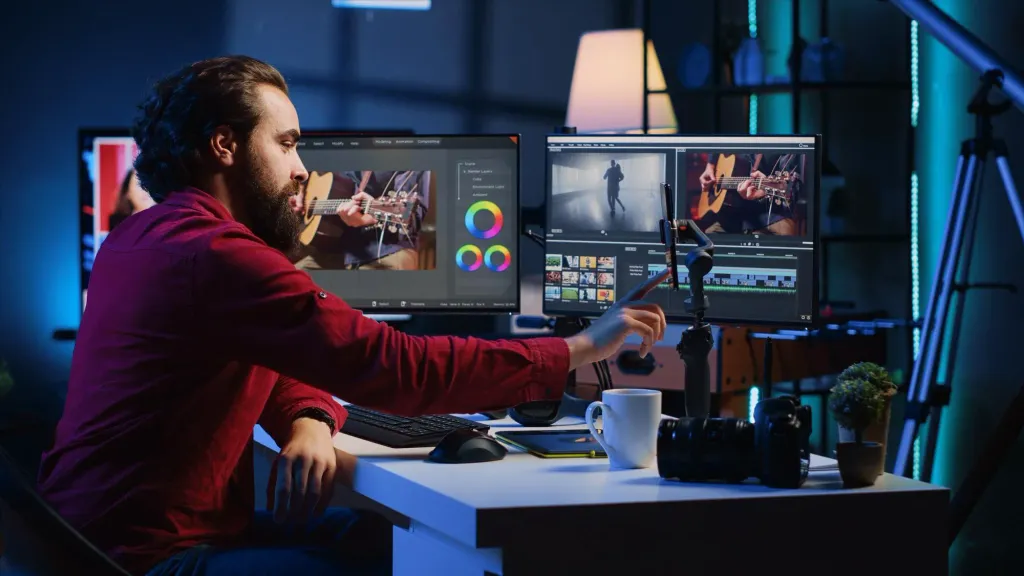What types of designers exist in the IT sphere?

Creative professions are often idealized. When a person from another industry imagines the work of a designer, they see a pleasant picture - you sit in a cafe with a Macbook, drink coffee, and create beautiful designs in two clicks. You can work as a freelancer, have a free work schedule and fly to Bali to spend the winter. Sounds good, right? However, this idyll rarely corresponds to reality.
In fact, the work of a designer is often not related to creativity, but to analytics, research, and testing. It involves a lot of hard and soft skills, which vary greatly depending on which design direction you decide to develop.

Graphic designer
A graphic designer is a creative professional who creates visual concepts for marketing and advertising creatives. They develop logo designs, posters, packaging, promotional materials, and other visual elements that reflect ‘s ideas and brand messages. These can be digital and printed materials.
Main tasks:
-
creation of logos, corporate identity;
-
development of layouts for print and web (flyers, posters, packaging);
-
visual communication through colors, fonts and composition.
Required skills:
-
basics of composition, typography, coloring;
-
ability to work with text and visuals;
-
creative thinking.
Tools:
-
Adobe Photoshop, Illustrator, InDesign;
-
digital drawing tablet;
-
color management system (Pantone, CMYK, RGB).

UX/UI designer
UX/UI designer is responsible for creating interfaces for websites and applications that provide the best possible user experience with the product.
UX (User Experience) designer analyzes and understands user needs, generates ideas and creates prototypes to improve user interaction with the product.
UI (User Interface) designer is responsible for the appearance of the product: interface design, placement of elements on the screen, colors and fonts.
Given the different functional responsibilities, the required skills for a UX and UI designer are slightly different. For UX, analytical skills, understanding of user behavior and needs, as well as technical features of the product are important. Valuable skills for a UI designer are creating aesthetic, user-friendly, and effective interfaces, i.e. implementing creative ideas that will satisfy user needs and achieve business goals.
Main tasks:
-
development of interfaces for websites, mobile applications;
-
analysis of user needs (UX - user experience);
-
creation of prototypes and interactive layouts (UI - user interface).
Required skills:
-
logical thinking, user experience analysis;
-
knowledge of usability principles;
-
ability to test hypotheses and collect feedback.
Tools:
-
Figma, Sketch, Adobe XD;
-
Miro, Notion, Maze (for research);
-
knowledge of HTML/CSS basics will be a plus.

Web designer
A web designer thinks over and creates the architecture and appearance of websites, develops a design concept and interface. Important characteristics of this specialist include skills in working with graphic programs, understanding the basics of composition theory, color, typography, and UX/UI design principles, the ability to analyze the target audience and meet user needs, while achieving business goals.
Main tasks:
-
creating websites - user-friendly, adaptive, stylish;
-
thinking through the structure and interaction of pages;
-
cooperation with developers.
Required skills:
-
responsive design, HTML/CSS basics;
-
SEO-oriented thinking;
-
composition and color skills.
Tools:
-
Figma, Adobe XD, Webflow;
-
WordPress, Tilda;
-
basic code editors (VS Code).

Motion designer
Animation designers, or animators, create moving images that tell stories or convey information. Animators mostly specialize in freehand drawing, creating computer-generated images or 2D/3D characters.
A motion designer is a kind of combination of a graphic designer and an animator. They develop animated designs for various media formats: videos and presentations, digital advertising, and GIFs.
The difference between animation and motion designers lies in the projects they work on. Animators often work on creating characters and environments, while motion designers create graphics and visual effects.
Another difference between these two types of designers is based on specific skills. It is important for animators to understand traditional animation techniques such as drawing and composition, as well as to understand anatomy and character creation. In contrast, motion designers need to have skills such as typography and visual language, as well as experience in graphic design.
Main tasks:
-
creating animations for advertising, videos, presentations;
-
working with video content and visual effects.
Required skills:
-
understanding the principles of animation (movement, tempo, timing);
-
working with sound, video, and graphics simultaneously;
-
attention to detail.
Tools:
-
Adobe After Effects, Cinema 4D, Blender;
-
Adobe Premiere Pro, Final Cut Pro (монтаж).

Game designer
A game designer designs the game experience, is responsible for creating the internal structure and gameplay of games, develops scenarios, mechanics, and basic game elements. The task of this specialist can be compared to the work of a movie director: they generate ideas and communicate them to the performers.
The must-have for a game designer is to love playing games, analyzing them, understanding what components a game consists of, following trends and what users are interested in. Game designers do not need to know programming languages, as the implementation of ideas at is mostly done by technical specialists.
Important traits for a game designer are a broad outlook, including basic knowledge of mathematics, physics, geography, chemistry, history, as some game plots and settings require the most realistic reproduction. Good communication and organizational skills, and the ability to communicate your idea are also essential for the successful implementation of the project.
Game designers can work in game development studios, IT companies in collaboration with programmers, artists, animators and other specialists.
Main tasks:
-
development of the game concept and its basic mechanics;
-
design of levels, tasks, progression systems;
-
creation of documentation (GDD - Game Design Document);
-
testing of gameplay and balancing;
-
interaction with artists, programmers, and scriptwriters.
Required skills:
-
analytical and systemic thinking;
-
creative imagination, knowledge of the logic of building game worlds;
-
basic knowledge of player psychology;
-
ability to work in a team and clearly formulate ideas;
-
understanding of genres, trends, game engines.
Tools:
-
game engines: Unity, Unreal Engine;
-
creation of documentation: Google Docs, Notion, Miro;
-
spreadsheet editors for balancing: Excel, Google Sheets;
-
prototyping tools: Twine, Construct, GameMaker Studio.
Conclusion
Design professions cover a wide range of tasks, from static images to dynamic animation and complex user interaction. Each area requires both creative approach and technical training. It is important not only to have the tools, but also to understand the design logic, aesthetics, and needs of the people for whom the product is being created.
A successful designer is someone who is constantly learning, experimenting, and improving their skills. The field of design is a space of unlimited opportunities for self-expression and influence on the world.
